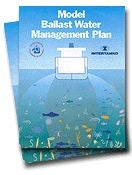 |
 |
 |
 |
The International Response
|
In response to the threats posed by invasive marine species,
the United Nations Conference on Environment and Development (UNCED)
held in Rio de Janeiro in 1992, in its Agenda 21 called on the
International Maritime Organization (IMO) and other international
bodies to take action to address the transfer of harmful organisms
by ships.
Click here to view the relevant section of
Agenda 21
|
 |
As a specialised agency of the
United Nations responsible for the international regulation of ship
safety and the prevention of marine pollution, IMO is the most appropriate
body to address this issue. By 1992 it had already been active in ballast
water issues for over ten years.
Assembly Resolution and Guidelines
 The member countries of IMO have developed "Guidelines for the
control and management of ships’ ballast water, to minimise the transfer
of harmful aquatic organisms and pathogens". These Guidelines were
adopted by the IMO Assembly in 1997, by resolution A.868(20). They replace
earlier, less comprehensive Guidelines adopted in 1993. Management and
control measures recommended by the Guidelines include:
The member countries of IMO have developed "Guidelines for the
control and management of ships’ ballast water, to minimise the transfer
of harmful aquatic organisms and pathogens". These Guidelines were
adopted by the IMO Assembly in 1997, by resolution A.868(20). They replace
earlier, less comprehensive Guidelines adopted in 1993. Management and
control measures recommended by the Guidelines include:
-
Minimising the uptake of organisms during
ballasting, by avoiding areas in ports where populations
of harmful organisms are known to occur, in shallow water
and in darkness, when bottom-dwelling organisms may rise
in the water column.
-
Cleaning ballast tanks and removing muds
and sediments that accumulate in these tanks on a regular
basis, which may harbour harmful organisms.
-
Avoiding unnecessary discharge of ballast.
-
Undertaking ballast water management procedures,
including:
-
Exchanging ballast water at sea, replacing it with
‘clean’ open ocean water. Any marine species taken on
at the source port are less likely to survive in the
open ocean, where environmental conditions are different
from coastal and port waters.
-
Non-release or minimal release of ballast water.
-
Discharge to onshore reception and treatment facilities.
Click here to view the Ballast
Water Guidelines A.868(20)
|
|

Model Management Plan
The shipping industry has also been very active in helping to address
invasive marine species and participates actively in the IMO Marine
Environment Protection Committee (MEPC) Ballast Water Working Group.
In particular, the International Chamber of Shipping (ICS) and the International
Association of Independent Tanker Owners (INTERTANKO) and Classification
Societies have published Model Ballast Water Management Plans. They
give practical guidance for the implementation of the IMO Guidelines
on-board ships.
|
International Legal Regime
All of the approaches recommended under the IMO
Guidelines are subject to limitations. Reballasting at sea currently
provides the best-available risk minimisation measure, but is subject
to serious ship-safety limits. Even when it is able to be fully implemented,
this technique is less than 100% effective in removing organisms from
ballast water.
In recognition of the limitations of the A.868(20)
Guidelines, the current lack of a totally effective solution and
the serious threats still posed by invasive marine species, IMO member
countries also agreed to develop a mandatory international legal regime
to regulate and control ballast water.
This culminated in adoption of the International
Convention for the Control and Management of Ships' Ballast Water and
Sediments in February 2004.
|
|

|
Click here to view the Summary
of the Convention Requirements
|
|
 |
 |
 |
 |
|
|




